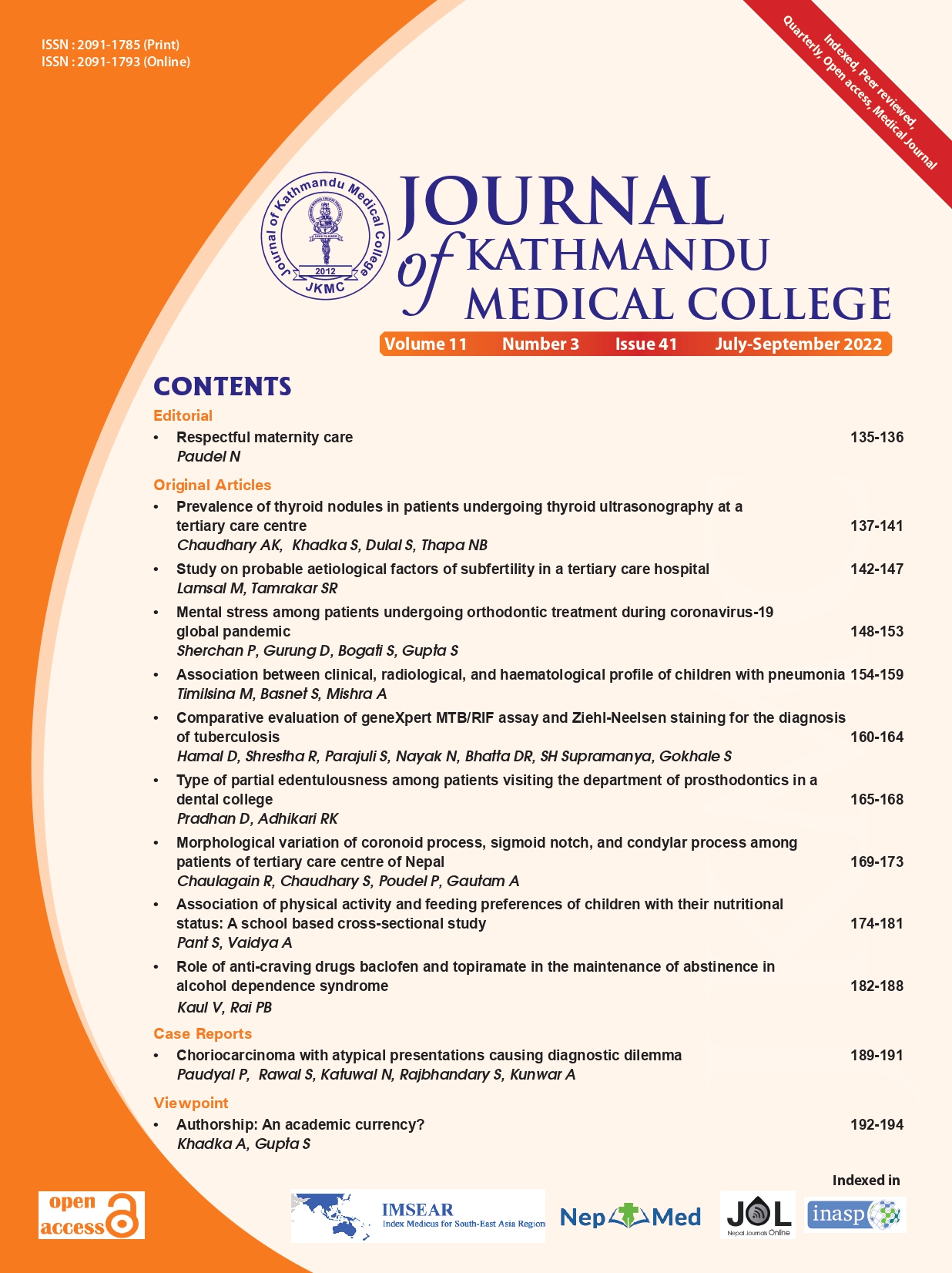Morphological variation of coronoid process, sigmoid notch, and condylar process among patients of tertiary care centre of Nepal
DOI:
https://doi.org/10.3126/jkmc.v11i3.50902Keywords:
Coronoid process, Condylar process , Morphology, Orthopantomograms, Sigmoid notchAbstract
Background: Mandibular ramus undergoes remodelling with time. The remodeling is also influenced by factors such as ageing, dental status, gender, stress, trauma, force exerted during occlusion, and joint diseases. Studies have reported variations in morphology of coronoid process, condylar process, and sigmoid notch of the mandible.
Objectives: To assess the morphological variations of processes of mandible and the sigmoid notch in a tertiary care centre of Nepal.
Methods: A retrospective study was conducted at Chitwan Medical College. This study included 310 orthopantomograms (OPGs) retrieved from the archives of the hospital data from 2022 May-June. All OPGs were taken with same radiographic equipment. Data taken in predesigned proforma were entered and analysed in SPSS v.16. Descriptive statistics was used to explain the results in tabulated form.
Results: Among 310 OPGs assessed, 188 (60.6%) were female and rest male. Angled mandibular condyle was prevalent on both right 123 (39.7%) and left side 134 (43.2%). More than 50% of sigmoid notch was of sloping shape on both right and left side. Triangular type of coronoid process was present 185 (59.7%) on right side and 183 (59.0%) on left side. Among the coronoid process types, triangular was found more in male and females on both right and left sides.
Conclusion: This study concluded that the angled type of condylar process, sloping type of sigmoid notch, and triangular type of coronoid process were more prevalent on both right and left side. All three parameters were also observed to be prevalent in females suggesting gender variation.
Downloads
References
Sahithi D, Reddy S, Divya Teja DV, Koneru J, Sai Praveen KN, Sruthi R. Reveal the concealed - Morphological variations of the coronoid process, condyle and sigmoid notch in personal identification. Egyptian Journal of Forensic Sciences. 2016;6(2):108-13. [ Full Text | DOI]
Khanal P. Study of Mandibular Condyle Morphology using Orthopantomogram. Journal of Nepal Dental Association. 2020;20(30):1-5. [ Full Text]
Ashwinirani S, Patil ST, Nair B, Rajmane Y, Kamala K. Morphological variations of condylar process and sigmoid notch using Orthopantomograms in Western part of Maharashtra population. methods. 2018;2:3. [ Full Text | DOI]
Shakya S, Ongole R, Nagraj SK. Morphology of coronoid process and sigmoid notch in orthopantomograms of South Indian population. World J Dent. 2013;4(1):1-3. [ Full Text | DOI]
Mathew AL, Sholapurkar AA, Pai KM. Condylar changes and its association with age, TMD, and dentition status: a cross-sectional study. International Journal of Dentistry. 2011 Oct 31;2011.. [PubMed | Full Text | DOI]
Anisuzzaman MM, Khan SR, Khan MT, Abdullah MK, Afrin A. Evaluation of Mandibular Condylar Morphology By Orthopantomogram In Bangladeshi Population. Update Dental College Journal. 2019;9(1):29-31. [Full Text | DOI]
Sonal V, Sandeep P, Kapil G, Christine R. Evaluation of condylar morphology using panoramic radiography. Journal of Advanced Clinical & Research Insights. 2016;3:5-8. [Full Text | DOI]
Shakya PR, Nyachhyon R, Pradhan A, Tamrakar R, Acharya S. Morphology of condyle-a radiographic study. Journal of Chitwan Medical College. 2022;12(1):17-20. [ Full Text | DOI]
Nagaraj T, Nigam H, Santosh HN, et al. Morphological variations of the coronoid process, condyle and sigmoid notch as an adjunct in personal identification. Journal of Medicine, Radiology, Pathology & Surgery. 2017;4(2):1-5. [Full Text | DOI]
Manoj M, Mathew L, Natarajan S, Yellapurkar S, Shetty S, Denny C, et al. Morphometric anlaysis of mandibular coronoid, condyle and sigmoid shape using panoromic view for personal identification in south Indian population. J Clin Imaging Sci. 2022;12:25. [PubMed | Full Text | DOI]
Kasat P, Bhuiyan P. A study on coronoid process of the dry adult human mandibles. Journal of the Anatomical Society of India. 2016;65(1):9-14. [Full Text | DOI]
Al-Saedi AIL, Riad A, Al-Jasim NH, Bahaa A. A panoramic study of the morphology of mandibular condyle in a sample of population from Basrah city. Int J Morphol. 2020;38(6):1707-12. [ Full Text | DOI]
Dahal S, Atreya A, Gupta SP, Natarajan S. Oval Type of Human Mandibular Condyle in Panoramic Radiographs of a Tertiary Care Centre: A Descriptive Cross-sectional Study. JNMA J Nepal Med Assoc. 2022 Jun 1;60(250):525-8. [PubMed | DOI]
Jawahar A, Maragathavalli G. Analysis of condylar morphological variations using digital panoramic radiographs-a retrospective study. Indian Journal of Public Health Research & Development. 2019;10(11). [DOI]
Tapas S. Morphological variations of coronoid process in dry adult human mandibles. Indian J Basic Appl Med Res. 2014;3(2):401-405. [ Full Text ]
Callewaert F, Sinnesael M, Gielen E, Boonen S, Vanderschueren D. Skeletal sexual dimorphism: relative contribution of sex steroids, Growth Hormone-Insulin-Like Growth Factor-I (GH-IGF-I) and mechanical loading. J Endocrinol. 2010;207(2):127-34. [PubMed | Full Text | DOI]
Downloads
Published
How to Cite
Issue
Section
License
Copyright (c) 2022 Journal of Kathmandu Medical College

This work is licensed under a Creative Commons Attribution-NonCommercial 4.0 International License.
Copyright © Journal of Kathmandu Medical College
The ideas and opinions expressed by authors or articles summarized, quoted, or published in full text in this journal represent only the opinions of the authors and do not necessarily reflect the official policy of Journal of Kathmandu Medical College or the institute with which the author(s) is/are affiliated, unless so specified.
Authors convey all copyright ownership, including any and all rights incidental thereto, exclusively to JKMC, in the event that such work is published by JKMC. JKMC shall own the work, including 1) copyright; 2) the right to grant permission to republish the article in whole or in part, with or without fee; 3) the right to produce preprints or reprints and translate into languages other than English for sale or free distribution; and 4) the right to republish the work in a collection of articles in any other mechanical or electronic format.




